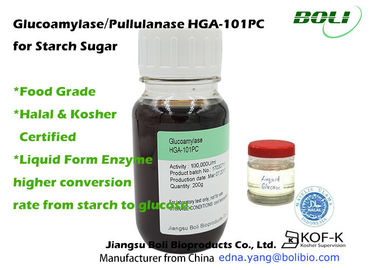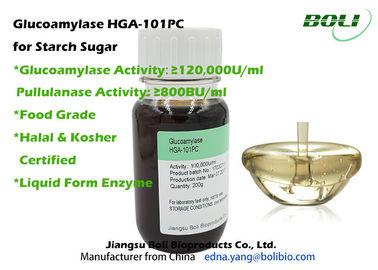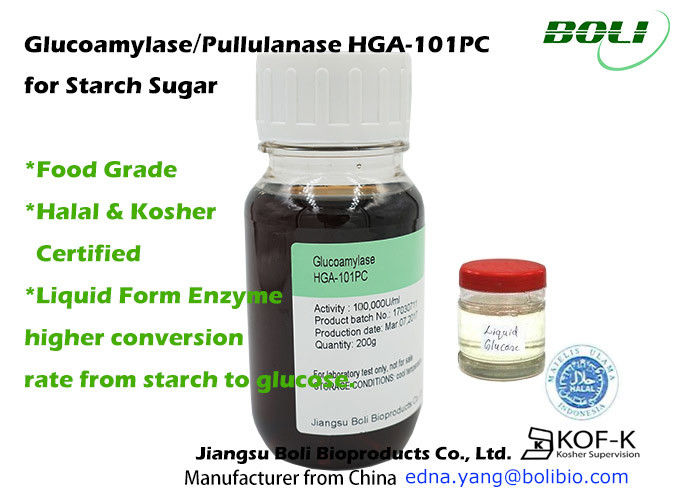Stach Sugar Enzymes Pullulanase Enzyme 1400B U / ml , Glucoamylase100,000U/ml Enzymes with Halal and Kosher Certificate
Product Details:
| Place of Origin: | Jiangsu China |
| Brand Name: | Boli |
| Certification: | Halal, Kosher ISO9001, ISO14001, ISO22000 |
| Model Number: | Glucoamylase/Pullulanase HGA-101PC |
Payment & Shipping Terms:
| Minimum Order Quantity: | 400kg |
|---|---|
| Price: | Negotiable |
| Packaging Details: | 25kg, 30kg HDPE drums, 1125 IBC totes for liquid |
| Delivery Time: | 15-20 days |
| Payment Terms: | T/T, L/C , D/P |
| Supply Ability: | 1000MT to 1500MT Per Year |
|
Detail Information |
|||
| Application: | Glucoamylase/Pullulanase For Starch Sugar | Declared Enzyme: | Glucoamylase/Pullulanase |
|---|---|---|---|
| Glucoamylase Activity: | 100,000U/ml (minimum) | Pullulanase Activity: | 1,400BU/ml (minimum) |
| Appearance: | Yellow Brown Liquid | Certificate:: | Both Halal And Kosher Certified |
| High Light: | amyloglucosidase enzyme,beta glucanase enzyme |
||
Product Description
Glucoamylase HGA-101PC
Glucoamylase/Pullulanase Higher conversion rate from starch to glucose.
| Glucoamylase Activity: | 100,000U/ml (minimum) |
| Pullulanase Activity: | 1,400BU/ml (minimum) |
| Appearance: | Yellow brown liquid |
| Product pH: | 3.0 to 5.0 |
| Specific Gravity: | 1.10 to 1.25 g/ml |
BENEFITS FOR STARCH SUGAR INDUSTRY
![]()
liquid glucoe
Use of HGA-101PC ensures the following benefits for starch sugar industry:
- Greater conversion rate from starch to glucose
- Maximized utilization of raw materials
- Suitable for the production of glucose with DX≥97%
- Capable to work with higher concentration substrate
- Stable activity ensures stable dosage rate, no need to adjust dosage for each batch
DESCRIPTION
HGA-101PC is a Glucoamylase / Pullulanase blended enzyme. It contains robust Glucoamylase and starch debranching enzyme - Pullulanase. The Glucoamylase is produced from controlled fermentation of selected strains of Aspergillus niger , whilst the Pullulanase is produced from robust strains of Bacillus licheniformis. Glucoamylase can hydrolyze alpha-1,4 glucosidic linkages from the non-reduction end of starches to release glucose, whilst Pullulanase can specifically cleave the alpha-1, 6 glycosidic bond of the branching point of amylopectin, and cut out the entire branch structure to form amylose. Thus HGA-101PC has a higher conversion rate from starch to sugar.
This compound enzyme product has been specially designed for the production of starch sugar.
EFFECT OF pH AND TEMPERATURE ON ACTIVITY
HGA-101PC can work at pH range from 3.0 to 5.5. For maximum activity, the optimal pH range is 4.0 to 4.5, with an optimum pH at 4.2(See Figure 1).
![]()
HGA-101PC can work at temperatures from 30 to 65°C. For maximum activity, its optimal temperature is from 60 to 62°C. Normally, this product will be completely inactivated if the saccharified liquid is boiled for 5 minutes at 80°C(See Figure 2).
![]()
USAGE GUIDELINES
Add this product into liquefied starches of substrates such as corn, wheat, barley, tapioca, rice, potatoes, etc. can convert the starches into glucose.
Recommended optimal temperature for industrial operations is 59 to 62°C, pH 4.1 to 4.5.
First, adjust pH; then add this product. Dosage rate depends on the type of raw materials and actual processing conditions. It is recommended to conduct several trials to determine the optimal dosage rate. A generally recommended dosage rate for HGA-101PC is 0.30 to 0.5kg / TDS. The saccharification should be kept for 32 to 48 hours depending on its actual processing requirements.
PACKAGING, STORAGE AND SHELF-LIFE
- Standard packaging is 25kg, 30kg food-grade HDPE drums or 1125 kg IBC totes.
- Customized packaging is available upon request.
- Typical shelf-life is six months if it is stored below 25°C in its original packaging, sealed and unopened, protected from sunlight.
- Its shelf-life will be eighteen months if this product is stored properly at 0∼10°C.
- HGA-101PC has been formulated for optimal stability. Prolonged storage and/or adverse conditions such as higher temperature may lead to a higher dosage requirement, therefore should be avoided.
SAFE HANDLING OF ENZYMES
Inhalation of enzyme dust and mists should be avoided. In case of contact with skin or eyes, promptly rinse with water for at least 15 minutes. For detailed handling information, please refer to the Safety Data Sheet.




